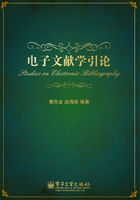
Preface
Electronic bibliography is born in the age of information, showing a number of characteristics being different from the traditional bibliography, which gives us a possibility of studying on electronic bibliography.From the theories of traditional bibliography and electronic information technology, a more comprehensive framework for electronic bibliography discipline should be built by the analysis and exploration of electronic bibliography.
Electronic bibliography has the two basic characteristics: First, being on CD-ROM, disk or other electronic form; second, browsing information through computers by recording, storage, transmission and retrieval.
Electronic bibliography in accordance with storage methods, carrier forms, editing and use patterns, information processing level and the different formats will arrive at different classification, which is conducive to recognize different electronic bibliography.
Electronic bibliography is generated by entry, scanning, photography, recording, multimedia production, etc.Its storage mediums would be a tape, a floppy disk, CD-ROMs, hard drives.Its transmission ways would be a digital network publishing, etc.
Electronic bibliography forms can be divided into text and hypertext, which can be automatic summaries, hypertext navigation and the measure of the text.
Electronic bibliography search ways can be divided into the computer resources search and digital bibliography retrieval, which search engines have many types with different features.
Development and use of electronic bibliographies have a great significance, including the collection of electronic bibliographies, knowledge acquisition, creating personal digital libraries, documentation processing.At the same time, we should establish a sense of security for electronic bibliographies and implement practical measures of protection to prevent non-security factors.
Evaluation of electronic bibliography has a different item system to evaluate the quality of the original literature, technical reliability and operational stability, confidentiality and anti-virus capabilities, diversity and ease of retrieval, documentation, operating environment and web-speed as well as the homepage designing style.
Finally, facing a deluge of modern electronic bibliographies, we should reflect on the cultural philosophy and ask any questions, which include reflecting on the world built by the “bits”, questioning people who would act as the “Genesis” Lord, asking whether people should know the significance of rhythms and then know how to live.